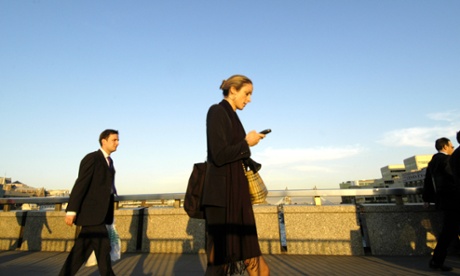
Not that it really matters, but on Friday I missed a subway train because the woman in front of me drifted placidly to a standstill on the stairs, distracted by something on her smartphone. In hindsight I realise that this was probably a subway-specific thing: it was her determination to retain network coverage, I'm guessing, that rendered her oblivious to the people behind her. But as I stalked along the platform, cursing under my breath, I mentally filed the incident alongside a number of recent above-ground encounters. These days, it seems, I'm forever navigating around people utterly absorbed in their phones.
In fact, I'll go further, though I admit I have zero scientific evidence for the following observation: here in New York, in the last few months, it feels as though we've crossed a threshold. Smartphones have been ubiquitous for years, of course – but much more recently, there seems to have been a shift in social norms. For many people, the unwritten rules of sidewalk choreography now include this: if what I'm reading or watching on my phone is sufficiently interesting to me, it's entirely up to you to get out of my way, just as if I were very frail, or three years old, or blind. Or a lamppost.
I know, I know: I sound like a curmudgeon. (This is because I am a curmudgeon.) But the consequences of "distracted walking" are graver than simply causing me annoyance, grave as that may be. According to research published earlier this year, injuries caused by cellphone distraction and requiring emergency room treatment shot up, in the US, from 559 in 2004 to 1,500 in 2010. Some victims walked off bridges, or into moving traffic; around two-thirds of the victims were under 25. Last year, a Los Angeles man was so busy texting he almost walked into a bear, while in Indiana a woman strolled straight into an icy river. The year before, a woman in Pennsylvania fell into a shopping mall fountain for related reasons – then threatened to sue the mall. You can watch video of her blunder here, but please don't do so on your iPhone while approaching me in the street.
And so I'd like to invite you to join me in a simple, legal, non-aggressive act of resistance: a "politeness enforcement tactic" designed to restore safety to our sidewalks. Next time you're implicitly required to alter your path to avoid colliding with an oblivious phone user … just don't, and see what happens.
This being a responsible news website, I obviously cannot suggest that you deliberately seek to steer into the paths of distracted walkers, though I suppose that's the logical extension of this approach. And just to be clear, you must still dodge people if you get within a few feet: we're trying to prevent accidents here, not cause them (or start fights). But based on my experiments so far, you'll never get that close. Distracted walkers aren't completely unaware of their surroundings, after all. It's just that their range of awareness is smaller. Once you finally impinge upon it, they'll look up, steer around you, and walk on, ever so slightly conditioned to pay more attention next time.
And believe me: performing a valuable public service has rarely been so entertaining.

